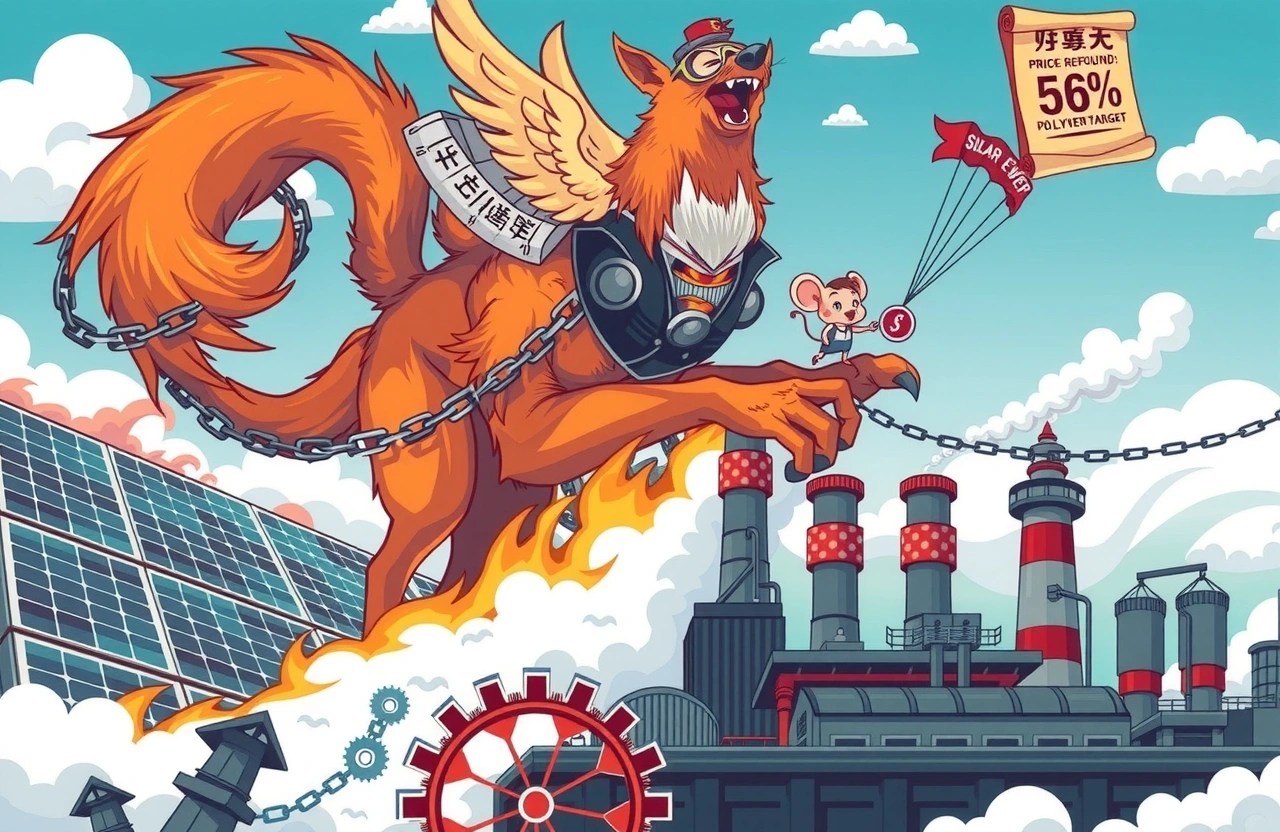– After a 50% sector decline over 3 years, solar PV stocks surged in early July
– Central government announces crackdown on ‘internal scroll’ competition and plans 56% polysilicon capacity reduction
– Rumored industry alliance forming $10B fund to consolidate excess capacity
– Polysilicon price targets suggest 29-43% rebound potential
Since July 2nd, China’s solar PV sector has experienced a vigorous rebound after enduring a brutal three-year bear market. Stocks like Yatong New Materials surged 33% and EGing Photovoltaic rose 26%, while industry giants Tongwei Co. and Daqo Energy jumped over 10%. This unexpected rally comes amid concrete signals that Beijing intends to force supply-side reforms upon the solar PV industry, representing a potential fundamental reversal after the sector’s 80% peak-to-trough collapse. As Minister Li Lecheng (李乐成) conveyed high-level directives ordering an end to ‘internal scroll’ competition, market participants wonder: Is this another false alarm or has the wolf finally arrived?
Government Signals Shift Toward Centralized Control
The catalyst emerged during the July 1st Central Financial and Economic Affairs Commission meeting, where authorities explicitly stated: “We will regulate enterprises’ low-priced disorderly competition according to law, guide enterprises to improve product quality, and promote the orderly exit of backward production capacity.” This marked a pivotal shift toward centrally directed industry consolidation within the solar PV sector.
Historical context illuminates the significance:
– The Commission (transformed from its 2018 predecessor) shapes macroeconomic policy frameworks
– Similar 2015 supply-side reforms revived steel/coal industries through forced capacity eliminations
Implementation Timeline Accelerates
The Ministry of Industry and Information Technology promptly convened leaders from Tongwei Co., GCL Group, Sungrow Power, and LONGi Green Energy on July 3rd. Meeting details revealed:
– Mandatory polysilicon production caps: 1.4 million tons by 2030 (versus current 3.23m ton capacity)
– Penalties for below-cost pricing strategies
These developments represent phase three of Beijing’s solar PV industry overhaul:
– 2024 July Politburo meeting: Initial warnings against ‘internal scroll’ competition
– 2024 Year-End Politburo: Commitment to comprehensive governance
– 2025 Government Work Report: Formal codification into national policy
Addressing Market Skepticism
Despite decisive signals, skeptics cite two primary concerns about solar PV industry reforms:
Structural complications:
– Private enterprise dominance complicates compliance versus state-controlled industries
– Employment impacts during economic headwinds
Current operational reality contradicts these reservations:
– Polysilicon capacity utilization rates plunged from 71% (March 2024) to 31% (March 2025)
– Smaller producers already suspended operations, mitigating forced-layoff risks
The $10 Billion Consolidation Blueprint
Industry rumors suggest substantive consolidation mechanisms are advancing:
– Leading polysilicon producers (Tongwei, GCL, Daqo, Xinte, East Hope, Asia Silicon) forming OPEC-like coalition
– Proposed 70 billion RMB ($9.6B) fund acquiring 1.4 million tons of excess capacity
– Fund structure: 120-180B RMB self-funded junior tranche supplemented by institutional senior capital
The economics support viability:
– Paying investment cost (~60K RMB/ton) enables 1.15m ton absorption
– Provides graceful exit for marginal producers versus bankruptcy scenarios
Polysilicon: The Reform Epicenter
Global supply chain positioning makes polysilicon consolidation’s immediate frontier:
– CRU/Bernreuter data: China produces 97% of global polysilicon
– Top 6 firms control 84.1% market share (Tongwei 21.5%, GCL 18.5%, Daqo 14.7%, Xinte 13.7%, East Hope 10.8%, Asia Silicon 4.9%
Price rebound catalysts appear imminent:
– Current price: 35K RMB/ton
– Cash cost benchmarks: Tongwei Inner Mongolia facility (27K RMB), GCL (28K RMB)
– Breakeven threshold: Major producers require 45K-50K RMB/ton
This implies potential price appreciation:
– Minimum upside: 29% to 45K RMB break-even
– Maximum upside: 43% to 50K RMB equilibrium
Upstream Industrial Silicon Challenges
Consolidation complications increase upstream:
– Industrial silicon producer concentration <60% (Hesco 30.1%, East Hope 11.1%, Xinte 8.1%)
– Global supply diversification (Brazil/US/Norway ~17.4%) hampers coordination
Investment Implications and Opportunity
Capital markets discounting mechanics remain premature:
– Sector valuations at historic lows after three-year capitulation
– Long-short ratio divergence emerging among top producers
Potential timeline mismatch creates opportunity:
– Valuation repair often precedes earnings confirmation
– Markets typically price policy impact quarters before financials
Identifying Primary Beneficiaries</h3
Projected beneficiaries:
– Vertically integrated leaders with polysilicon self-sufficiency
– Firms with sub-30K RMB cash cost advantages
The Turning Point Decision
For three years, solar PV investors navigated false dawns and broken support levels. Today’s stark divergence stems not from cyclical fluctuations but structural intervention. Shanghai Metals Market tracking confirms Tier-1 manufacturers accelerated procurement five days after the policy announcements.
Historical analogies offer perspective:
– Steel industry profits increased 300% post-2015 supply-side reform
– Coal producers’ ROE recovered from -5.3% to 12.9% within 18 months
Critical questions remain unanswered:
– Will environmental compliance enforcement accelerate consolidation?
– How swiftly can insolvency proceedings clear capacity?
Yet unprecedented policy alignment suggests trajectory alteration:
– Central commissions → ministerial coordination → enterprise implementation
For contrarian investors, solar PV’s despair-to-hope transformation might validate Chairman Mao’s adage: “The world is yours, as well as ours, but in the last analysis, it is yours.” Market dynamics now pivot from ‘whether’ to ‘when’—the wolf stands at the door.
Monitor Qinhuangdao polysilicon spot prices weekly via SCI99.com. Position strategically before quarterly earnings demonstrate margin expansion surprises.



